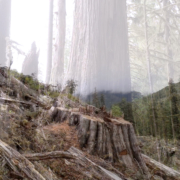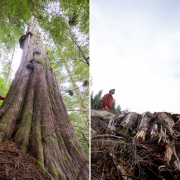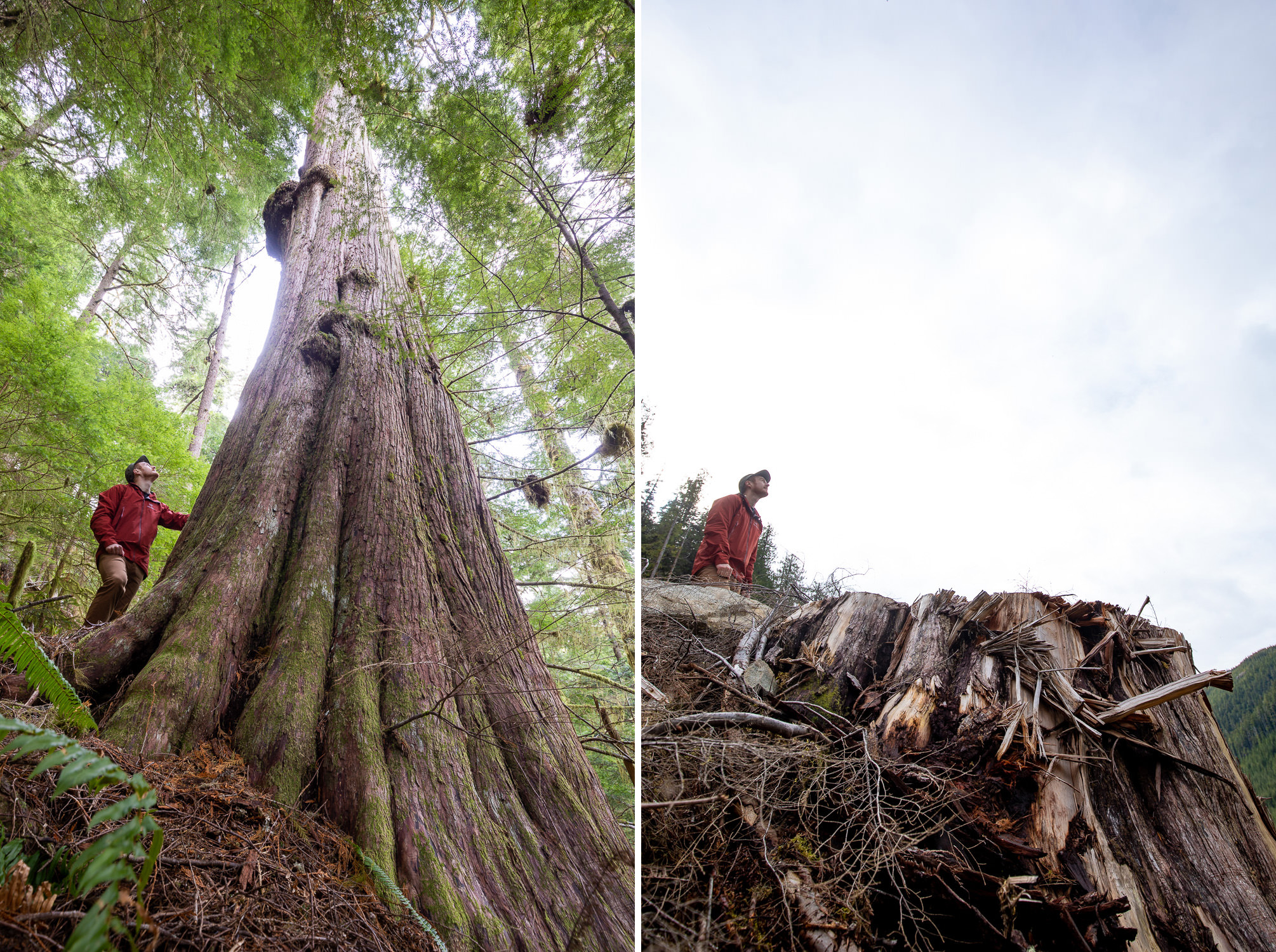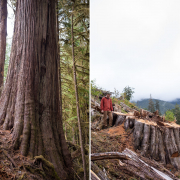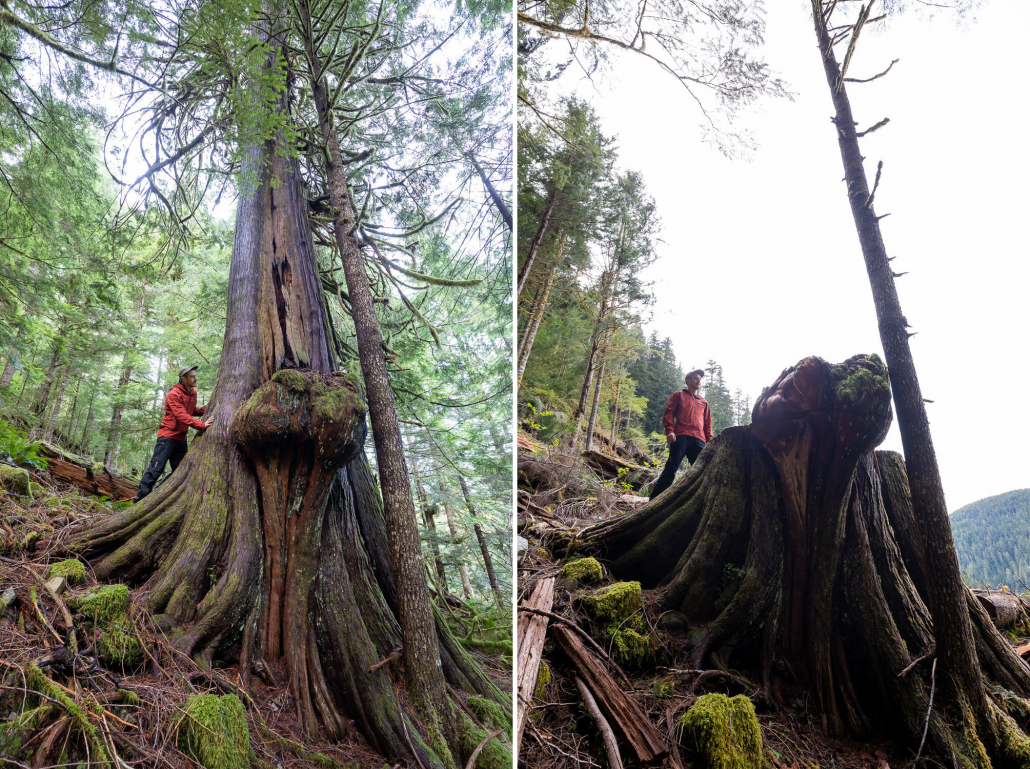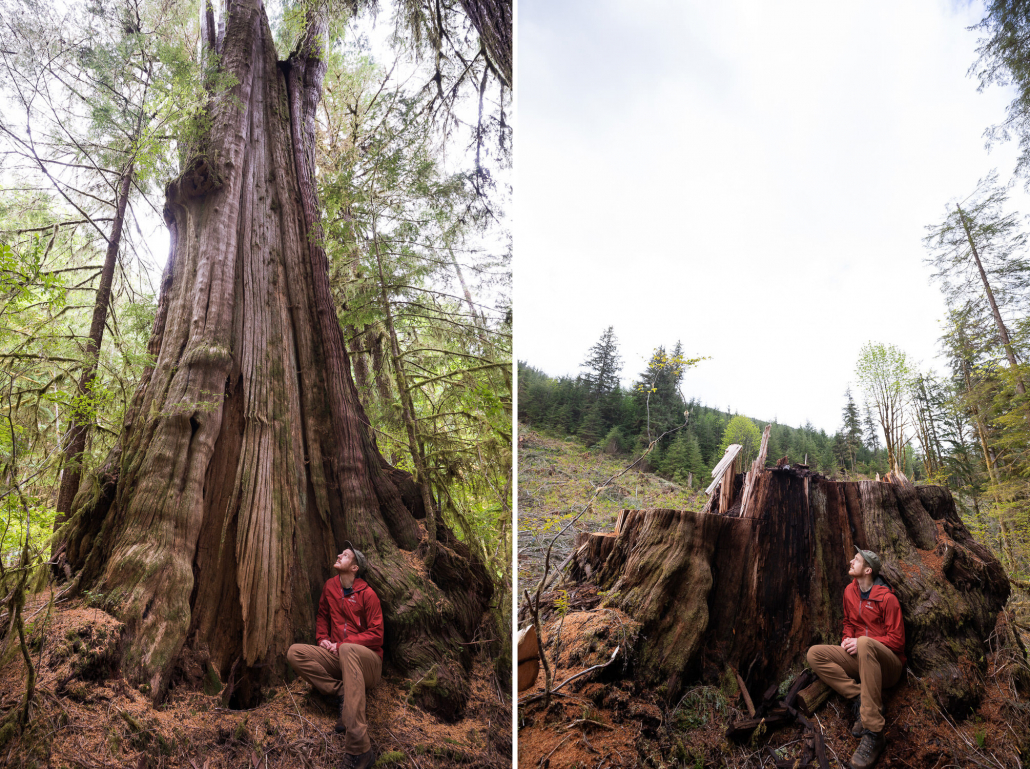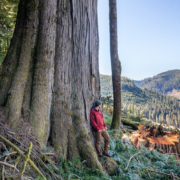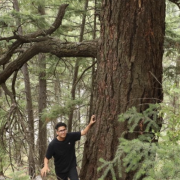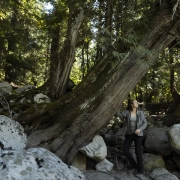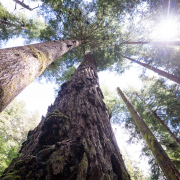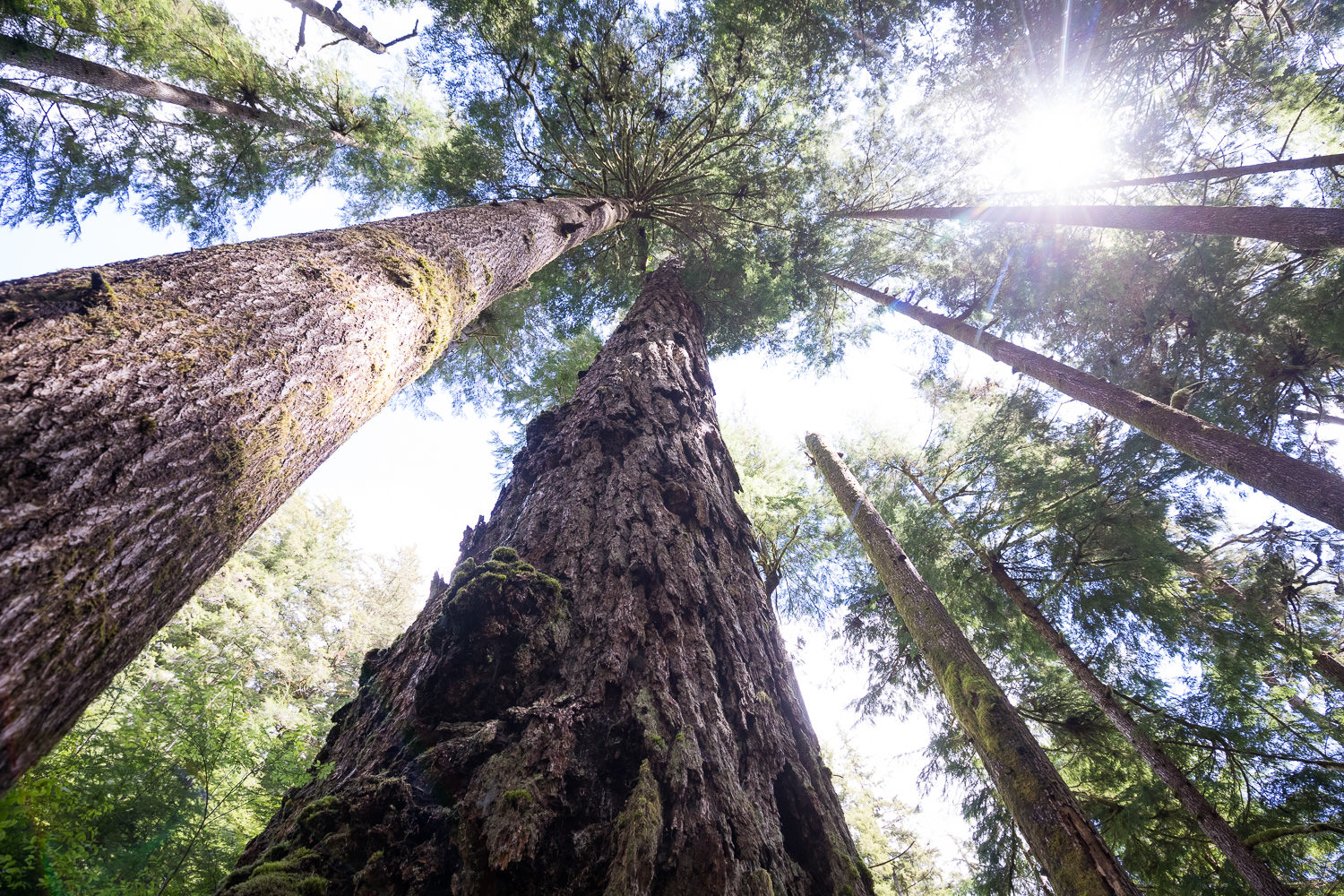October 10, 2022
The Globe And Mail
By Justine Hunter
Battered by climate disasters, community at Kanaka Bar looks to protect old growth forest and restore ecosystems in a way that supports the First Nation’s self-sufficiency initiatives and sustainable economic development.
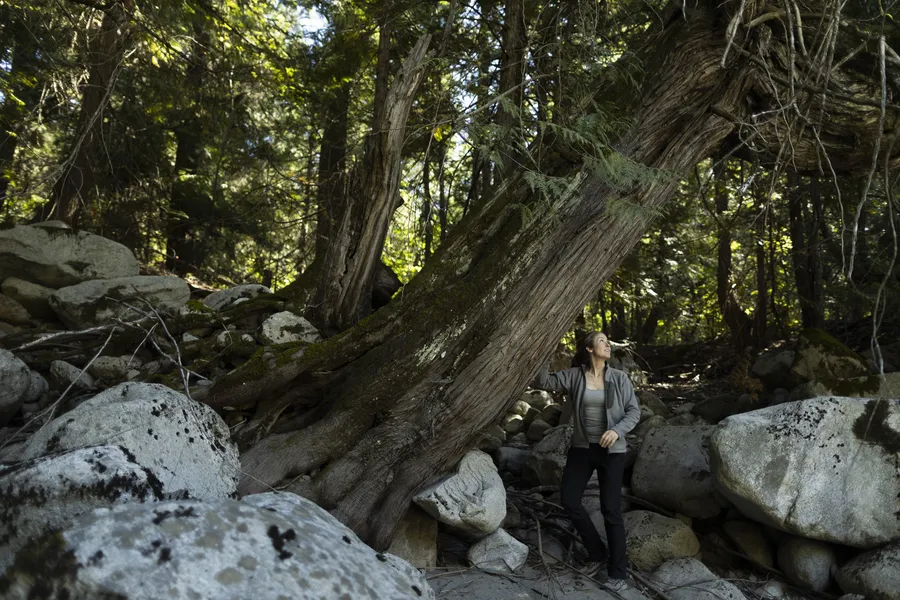
Celina Starnes of the Endangered Ecosystems Alliance stands under an old-growth Western redcedar near Kanaka Bar Indian Band, home to the T’eqt’’aqtn’mux, in British Columbia this past Sept. 21. PHOTOGRAPHY BY RAFAL GERSZAK/THE GLOBE AND MAIL
Overhanging a riverbank in the Fraser Canyon, an ancient Western redcedar shows signs of harvesting by past generations of the T’eqt’’aqtn’mux people. The gnarled tree is growing in one of the rarest and most endangered old-growth forests in British Columbia, and a newly sealed land deal has secured its protection. But for the surrounding forest, there is no certainty.
The Kanaka Bar Indian Band – also known as the T’eqt’’aqtn’mux – is proposing an Indigenous Protected and Conserved Area to preserve its ancient connection to these lands, and to protect a rich pocket of biodiversity for the planet. In the southern canyon, along the Fraser River, the province’s wet coastal and dry interior zones meet, allowing an unusual variety of species to mingle.
While logging companies have cleared large swaths of old growth in the traditional territories of the T’eqt’’aqtn’mux, evidence of this First Nation’s sustainable harvesting practices is still found in living trees that did not fall to commercial logging: Researchers have confirmed that branches and bark strips have been harvested here from select cedar trees since the early 18th century, or even before then.
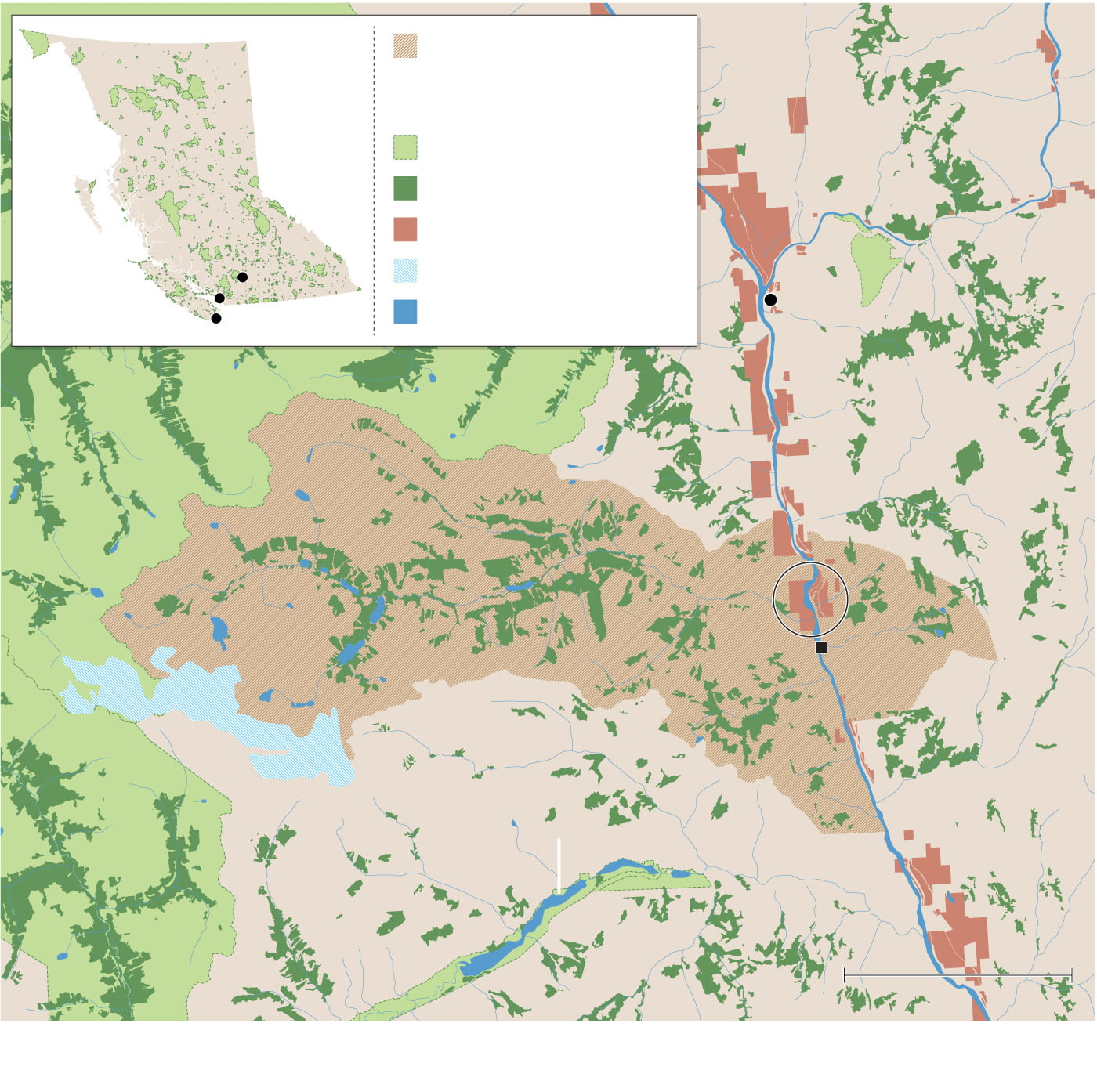
MURAT YÜKSELIR / THE GLOBE AND MAIL, SOURCE: NATURAL RESOURCES CANADA; BC DATA CATALOGUE; KANAKA BAR INDIAN BAND
But the protected area plan awaits the support of Ottawa and Victoria – approval that is caught in a protracted negotiation between the two levels of government over old-growth protection.
The objective of the proposed Indigenous protected area fits into a larger aim shared by the federal government.
Canada has made international commitments to protect 30 per cent of its lands and waters by 2030, and a recent report from World Wildlife Fund Canada says Indigenous-managed conservation will be key to achieving those targets.
Montreal will host a UN conference on biodiversity later this year and heading into that event, the Justin Trudeau government will be pressed to show how it intends to almost double the country’s existing protected areas by 2025 to meet its interim targets.
British Columbia, which boasts the greatest amount of biodiversity in the country, also has interests that align with the Kanaka Bar proposal: The provincial government has pledged to suspend logging in one-third of BC’s remaining’s old-growth forests to protect irreplaceable ecosystems that are disappearing under intensive forestry – but to do that with Indigenous consent, which has been slow to garner.
The Kanaka Bar proposals would hit the sweet spot for both governments: Kanaka Bar intends to protect and restore rare ecosystems in a way that supports the First Nation’s self-sufficiency initiatives and sustainable economic development.
The community’s impetus for conservation has been shaped by commercial logging – 15 per cent of the forests in its proposed conservation area has been logged since the 1960s – mostly in the rich valley bottoms where the greatest old growth is found.
The federal and BC governments are in protracted negotiations to reach a nature agreement that would include permanent old-growth protection.
However, the two sides remain at odds over funding, and which forests would be set aside. The federal government has offered $50-million specifically for BC old growth, a figure that the province dismissed as far too little. Ottawa, meanwhile, is awaiting the matching commitment from the province.
Steven Guilbeault, the federal Minister of Environment and Climate Change, toured an old-growth forest in BC on Sept. 1, using the visit as a backdrop to press the provincial government to reach an accord. “We will continue collaborating with the province to get a good deal to protect BC’s beloved nature,” he said in a statement at that time.
Patrick Michell, former chief of the Kanaka Bar Indian Band, was instrumental in launching the proposed T’eqt’aqtn Indigenous Protected and Conserved Area, and he said neither level of government has responded to the invitation to participate. But the plan will move forward anyway: “When we need to do something, we just do it,” he said in an interview.
His community has been buying up private lands when they become available, rather than waiting for the Crown to give them their land back. Their vision for climate resiliency does not include commercial logging of old growth.
“We want to keep the old growth, keep the carbon in the ground,” he said. “For us to have an economy for the next 100 years, we need to invest in something more sustainable and resilient.” Economic development is possible, but within a framework that supports Kanaka Bar’s goals. “We want to work with Canadian corporations. We want to work with the existing transportation industries. But there’s going to be a few new rules. You cannot exacerbate climate change.”
The only firm commitment to the Kanaka Bar conservation plan to date has come from a fledgling environmental non-profit, which bought a piece of private land to gift to the community.
The property known locally as Old Man Jack’s is a tiny parcel, a little more than three hectares, which was scooped up for just under $100,000. It is dwarfed by the more ambitious Kanaka Bar proposal to set aside a large chunk of the southern Fraser Canyon in the First Nation’s traditional territories, including roughly 125 square kilometres of old-growth forests. But it is a concrete start.
Old Man Jack’s property, purchased by the Nature-Based Solutions Foundation, is a showcase for the region, with its unusual mix of coastal and interior species: Ponderosa pine, Interior Douglas fir, Western redcedar, Bigleaf maple, all growing together. “This is peak biodiversity – as multicultural as you can get in a BC forest,” said Ken Wu, co-founder of the foundation, as he pointed out one of the largest Interior Douglas firs in the country.
Mr. Wu started campaigning for BC’s old-growth forests more than two decades ago. The foundation was created last year to raise money to purchase endangered ecosystems, sidestepping the conflict that has marked many campaigns against old-growth logging.
“Protests are important at times,” Mr. Wu said, “but to actually save old-growth forests, it is vital to ensure First Nations have the financial resources in order to realize their conservation visions,” he said. Many First Nations rely on forestry for revenue and jobs – and he said the provincial and federal governments need to bring substantial funding to the table to create viable alternatives.
“There’s no path to actually protect old-growth forests on the ground in British Columbia by going around First Nations communities and leadership,” Mr. Wu said.
The Fraser Canyon was at the epicentre of the twin climate disasters of 2021 in BC The main Kanaka Bar reserve is roughly 14 kilometres south of Lytton, the town destroyed by wildfire in June of 2021, and many members lost their homes in that fire. A series of atmospheric rivers in November then wiped out more homes, highways and other infrastructure, causing millions of dollars of damage to the Kanaka Bar’s run-of-the-river hydro electric facility.
For the past decade, the Kanaka Bar nation has worked on a climate adaptation plan, which has aims to create a self-sufficient community that can withstand whatever climate change brings in the next century. About 70 of the band’s 240 members live on reserve, getting their electricity from solar power. The nation has purchased provincial water rights to ensure their clean water supply. And community gardens supplement the food they obtain from their lands.
The T’eqt’aqtn Indigenous Protected and Conserved Area would help the entire Fraser Canyon’s climate resiliency, said Sean O’Rourke, the Kanaka Bar lands manager, because healthy ecosystems are the region’s best defence against natural disasters.
But it also aims to protect the T’eqt’’aqtn’mux’s archeological sites. Mr. O’Rourke pointed across the Fraser River to the remains of a stone-constructed fishing weir, disrupted by placer miners looking for gold. The rainstorms last November uncovered a petroglyph that is believed to be at least 8,000 years old. It was damaged when treasure hunters removed a piece of it with a jackhammer.
“These connections to the past and connections to the old way of life, that’s a finite thing,” Mr. O’Rourke said. “Once you damage something like that, you’re never going to get it back.”
Read the original article

